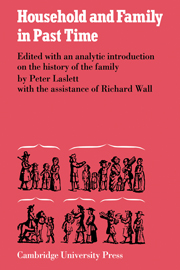Book contents
- Frontmatter
- Contents
- List of contributors
- Preface to the first impression
- Preface to the second impression
- 1 Introduction: The history of the family
- 2 Some demographic determinants of average household size: An analytic approach
- 3 The evolution of the family
- ENGLAND
- WESTERN EUROPE
- SERBIA
- 14 The zadruga as process
- 15 Houseful and household in an eighteenth-century Balkan city. A tabular analysis of the listing of the Serbian sector of Belgrade in 1733–4
- 16 Town and countryside in Serbia in the nineteenth-century, social and household structure as reflected in the census of 1863
- JAPAN
- NORTH AMERICA
- Bibliography
- Index
16 - Town and countryside in Serbia in the nineteenth-century, social and household structure as reflected in the census of 1863
Published online by Cambridge University Press: 02 November 2009
- Frontmatter
- Contents
- List of contributors
- Preface to the first impression
- Preface to the second impression
- 1 Introduction: The history of the family
- 2 Some demographic determinants of average household size: An analytic approach
- 3 The evolution of the family
- ENGLAND
- WESTERN EUROPE
- SERBIA
- 14 The zadruga as process
- 15 Houseful and household in an eighteenth-century Balkan city. A tabular analysis of the listing of the Serbian sector of Belgrade in 1733–4
- 16 Town and countryside in Serbia in the nineteenth-century, social and household structure as reflected in the census of 1863
- JAPAN
- NORTH AMERICA
- Bibliography
- Index
Summary
Balkan familial and household structure has been the subject of discussion and study for over a century, but not much attention has been paid to the specifics of size and kinship composition. If we give as a brief tentative definition of the zadruga an extended household composed of a father and his married sons and their offspring (paternal zadruga), or two or more married brothers and their children (fraternal zadruga), how many people in a given community actually lived in these types of households? What about the size of the households themselves? Much of the literature with respect to the zadruga seems to dwell on the exceptional case which is then described in detail. Such an approach, however, does not help us understand the conditions under which the majority of the people lived. In this chapter an attempt will be made to establish in a preliminary way specific data bearing on household size and composition as it existed in the nineteenth century in certain villages in central šumadija in Serbia (Orašac, Banja, Bukovik, Kopljare, Stojnik and Topola) and one emergent market town (Arandjelovac).
A glance at Tables 16. 1a–h establishes that with the notable exception of the market town the large majority of households contain six or more people accordingto the 1863 Census.
- Type
- Chapter
- Information
- Household and Family in Past Times , pp. 401 - 428Publisher: Cambridge University PressPrint publication year: 1972
- 12
- Cited by

